|
| |
|
|
| |
 |
The Rădăuţi war invalids 1918 - 1919, an unknown revenue stamp issue |
 |
|
 |
A short history
Immediately after the First World War and the break up of the Austro-Hungarian Empire the historical Romanian provinces of Bucovina, Transilvania and Besarabia united to form the Kingdom of Romania. A problem facing the new nation was the welfare of war invalids, widows and orphans and the State was faced with establishing measures for their rehabilitation; these included accommodation and such matters as the provision of artificial limbs. This required new methods of funding and one of the first of these was aided by the sale of special stamps.
A series of assistance measures were introduced, these included:
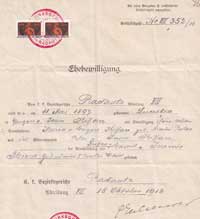
Early use
|
- The establishing of the service for "The protection of invalids and widows of war" in Bucovina (Ordinance 44/24th of April 1919);
- The "Fighters' Family" charity (established by Royal Decree nr. 3.890/23rd of December 1914 in Romania) continued to function in Bucovina as a service for the protection of invalids and widows of war and for the monitoring of the distribution of aid in all districts.
- Porto and franco assistance stamps were issued, to aid the "Fighters' Family" charity, and the social assistance stamps, by Law 2539 from 1920;
- The I.O.V.R. (Office for Invalids and War Widows) Cernăuţi district office is established, as proclaimed in the law published in the Official Bulletin nr. 119/2nd of September 1920.
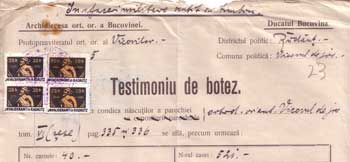
Photo 2
|
In the post-war chaos, most provinces continued to use existing administrative and legal practices and as new structures and fiscal laws were introduced they often functioned in parallel with the old laws. In Bucovina existing laws and ordinances relating to the management of public services, described in Decree number 3745/18.12.1918, and published in the Official Bulletin number 217/19.12.1918, remained in force. Only in July of 1920 with the establishment of the Directorship of United Territories and Administrative Unification (Official Bulletin 113/24.08.1920) were new laws officially implemented.
In the Bucovina administration permanent modifications continued to be introduced and the underlying trend stressed the independence of the province, both territorially and administratively. This is reinforced as almost all fiscal included in their titles the words "Duchy of Bucovina" or "Bucovina Country". The change from the old structures to the new was difficult, reflecting the problems of unification.
Of interest are the many articles published in the daily "Glasul Bucovinei", which replaced the "Czernowitzer Zeitung" in October 1918. These supported paramilitary groups and attacks on Romanian border posts, encouraged speculation with stamped banknotes, boycotted Romanians in occupying posts in the administration, using documents and stamps in German, not speaking Romanian in dealings with Romanian citizens and including the boycott of the distribution of stamps necessary for letters or the fiscal taxation of documents.
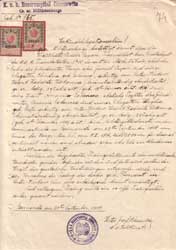
Hospital reserve
|
In the newspaper Glasul Bucovinei, number 38/29.12.1918, there is an eloquent editorial article concerning nationalism in the province:
"We march towards the nationalization of Bucovina.
We have in Bucovina 16 post-master positions, of these 6 are Jews, 5 are Germans, 3 Rutenians, 1 Polish and 1 Romanian. In the auxiliary service from the national government (Hilfsamt) are 15 Rutenians, 14 Germans, 9 Polish, 8 Jews and 3 Romanians. No comment"
Another article on the statistics of the Bucovina population, published in Glasul Bucovinei nr. 224/24.08.1919, reports the population of Romanians and other nationalities:
Romanians - 368149; Germans - 52914; Poles - 23301; Rutenians - 215605; Jews - 43655; Hungarians - 10182; Armenians - 282; other nationalities - 3500.
The Glasul Bucovinei for 39/31.12.1918 published an Appeal for an "An Asylum for the care of widows and orphans of war. "An appeal was opened for charity contributions and a public list subscription to obtain funds. The committee for the care of invalids will open craft workshops for the rehahibiliation of invalids and to provide work for them".
Countless articles were published in Glasul Bucovinei about the malpratices of city-hall employees, who asked huge amounts, taking advantage of illiterate persons or those incapable of completing their own requests. These abuses applied to a range of documents such as those necessary to gain employment, for the war invalid (Ordinance 71/27.07.1919) regarding tax exemption and stamp tax for the invalids (business asylum, etc. photo 2).
To obtain employment for any post it was a requirement that the following documents must be supplied and stamped: request, baptisimal certificate, local residence certificate, school attestation, morality attestation and, if relevant, military documents. The stamp tax for a request was of 2 lei.
The Glasul Bucovinei 9/22.03.1919 published an editorial article concerning the administration of Bucovina:
"From Cernăuţi another order was given to refuse requests, if they are not stamped (bearing stamps or stemples as they are called in German). Very well, we say, but where can a person buy these stamps, in Moldoviţa? People would be pleased if they could be found in Cernăuţi or other towns and cities. Further, if it happens that an invalid from Vatra - Moldoviţei could not make his request because his village does not have the necessary stamps, he needs to travel to Câmpulung which costs 40 coronas to obtain passage on a cart, money the poor man does not have - this is something that needs to be changed".
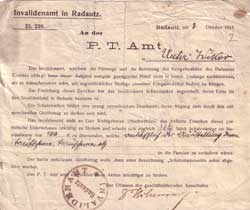
Photo 1
|
The Law 1638/20.04.1920, in article 103, regarding stamp taxes and registration provided:
"Until the issue of a single law, applicable in all the territories of the unified Romania, the stamp and registration laws that apply in Bucovina will remain in force, with the following modifications:
a) Stamp and registration taxes established under Austro - Hungarian laws remain in force and shall be collected by the promulgation of this Law in the amounts indicated, but in lei and bani. The amount which shall be considered as a basis for calculation shall be in lei and bani at a rate of 2 coronas to 1 leu..."
Revenue stamps, The Invalids from Rădăuţi
I discovered this stamp issue, 'Invalidenamt in Radautz' on 28 documents dated between October 1918 and November 1919. The date of issue for this stamp is still an enigma, the stamps are not listed in any catalogues, and reliable information about the period is extremely rare. It is possible that the stamps may have been printed earlier than October 1918, but I have found nothing to confirm this, and there are no documents describing the establishment of the Rădăuţi Invalid Office. I have researched all Official Bulletins, laws and decree-laws, ordinances, reports, memos, 'Imperial Law scripts' and many other documents published during in the period 1918 - 1920, but I have found nothing concrete regarding this issue. The only document, remotely relevant is part of my personal archive, it is in German and is reproduced in (photo 1):
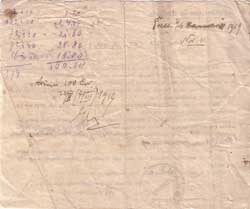
Photo 1 reverse
|
The Office of Invalids in Rădăuţi
Zl.226 Rădăuţi, on the 3rd October 1918
To
Post office
of...Vicovul de Jos
The Office of Invalids, whose task is to assist with the care of the war invalids of Rădăuţi district, cannot fulfill its task to assist to lessen the current precarious situation of some war invalids in the way it would desire.
To reach its goal the Office acquired Treasury stamps, the income from the sale being destined for the Rădăuţi Invalid Fund.
The Treasury stamps represent a category of stamps with a large discount, whose sale must always be covered in cash of the corresponding value.
The Invalid Office humbly addresses to Your Highness this sincere request to vigorously support this patriotic action and to arrange for 374 units of Treasury Stamps in a nominal value of 100 K to be sent to us. These are for sale to other parties and to be used for the issue of baptismal certificates, marriage certificates, etc.
The resulting amount shall be distributed to us as "Income from Treasury Stamps".
The Post Office is invited to vigorously support this action.
L.S. - Radautz Invalid Office Chairman of the Managerial Board

Photo 3
|
On the back of this document, in manuscript written in crayon, is an inventory with the number of stamps for each value, as follows: 72 x "10 = 7.20, 122 x "20 = 24.40, 72 x "30 = 21.60, 72 x "40 = 28,80, 36 x "50 = 18.00 Total 374 = 100.00
The same crayon was also used on the front of the document to note the number of stamp sent. Also on the back of the note is an inscription made with a pen using brown ink, Praes Nr. 11 from 3/16 January 1919, (similar writing with the same ink appears on the back, upper right corner on all documents issued in Rădăuţi, only the number and date being different) and under the inventory Avisat 100 Cor 22 February (7 March) 1919. These observations confirm that all documents were collected and handled at a single location.
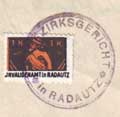
Photo 4
|
From this inventory we can deduce that there could be a value of 10 heller, but I presume that it was replaced with a nominal value of 1 Korona (100 heller). On all documents issued at Vicovul de Jos (the note is addressed to that postal office) for the month of January the stamp combinations total value 1 Korona: 50h +50h, 40h+40h+20h, 30h+30h+20h+20h, not one with the value of 10 heller or 1 Korona. Is it that the office did not have in stock values of 1 Korona, that they were only available at the Rădăuţi office or that the 10 heller value inventoried on the back of the note is not found anywhere? There are still many unanswered questions about the use of these stamps but I hope to find the answers even 91 years after their issue.
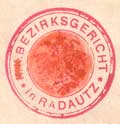
Photo 5
|
We can draw the conclusion that the Rădăuţi Invalid Office, which was the district office, already held a number of these stamps, only their distribution remaining to be solved and the collection of their value. The first record of the Rădăuţi Invalid Office dates from the 3rd of October 1918, before the take-over of the administration of Bucovina by Romanians, and this leads me to believe that it functioned according to imperial law (being most likely established at the end of the war), and this is why the stamps are in German. The issue can be considered to be local and can be included in Romanian catalogues as use of the stamps continued after the Union, even if the first known document at Rădăuţi is dated the 18th of October 1918. All documents issued in Rădăuţi are in German, and this continued for a whole year, long after the local administration had changed to function according to the Laws of The Kingdom of Romania. I suspect there was also some stubbornness by the public servants in using only German and the old imperial forms. These problems, specific to the period, make the study of these stamp issues even harder.
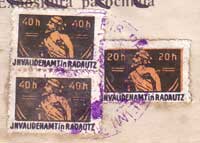
Photo 6
|
The stamps are printed on lithographic procedure in two colours, black and orange, on blank white paper, with line perforation, and the nominal values identified are 20 heller, 30 heller, 40 heller, 50 heller and 1 korona. They appear to have been two or more printings, undertaken by a local printer. For the orange color there are slight displacements of the print, as well as two different shades, reddish orange used in October 1918 in Rădăuţi and in June 1919 in Bilca, and yellowish-orange during 1919.
The stamps are applied on Announcements, Baptismal Testimonies, Baptismal Certificates, Medical Notices and many other documents issued in Rădăuţi in German (Ehebewilligung, Volljährigerflärung eines Műndels). On two other hand written documents from Vicovul de Jos, completed in German (Eheconsens and Aufnahmershrifl), there are references regarding stamp tax exemption. It appears that these stamps were restricted in use to places around the city of Rădăuţi , the second largest town in the district and the place where the office was located. From the study of archives with Bucovina documents I observed that in most places in the south of the province there is a better implementation of the laws and stamp circulation in comparison to the north of the district.
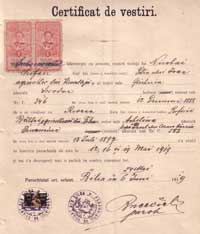
Photo 7
|
The stamps were cancelled by the issuing authority, be it district or parish. It is interesting to observe the evolution of the stamp of the military district of Rădăuţi*K.K. BEZIRKSGERICHT*in RADAUTZ (imperial district from Rădăuţi) found only on documents in German dated October 1918 (photo 3), January 1919 (photo 4) and July 1919 (photo 5). Probably, so as to avoid the expense of the manufacture of a new handstamp but to accord with the new administration, the letters k.k. were removed ("Köenigliche und Kaiserliche" - meaning imperial) as well as the central imperial eagle. The modified stamp was still in German, in spite of Order 830/02.05.1919 of the Delegate Minister for Bucovina requesting urgent replacement of German stamps, handstamps and inscriptions. On another document, dated 18.07.1919, the k.k. initials and the eagle are covered with ink of the same color as that used for the stamp. An original approach to the problem that occurs in other cases.
As a taxation level, I observed that the invalid tax applied was in value of 1 korona on documents "military affairs without stamp" (for military exempt from national tax charge, tax charges are more types and applied according to law, and disabled soldiers being exempted) (photo 2 and 6) and tax exempted, respectively 50 heller on the others, on which we also find a 2 lei revenue stamp (photo 7). I observed that in other places, Bilca, even if the stamp tax was correctly applied - 2 lei, or equivalent in lei and korona, the invalid stamps do not appear of identical value on the same type of document (photo 8).
There was a tax exemption for military personnel and invalids. Bilca is a village near Radauti. So on documents included in "military affairs without stamp",
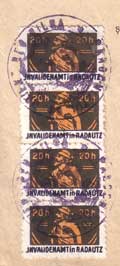
Photo 8
|
only the invalid stamp was collected (as charity probably) not the fiscal stamp (a tax which they did not pay). On others it appears that the invalid tax was not collected at the same rate.
Three documents, for the same purpose, and issued by the same institution over a 2 month period, bear three different taxes (80h in 26 May 1919, 40h in 2 June 1919 and 50h in 6 June 1919). Can we draw the conclusion that the invalid tax was voluntary, or was it locally modified? Did the stock of stamps only include these values? Possibly, but until we have enough documentary material, we can only presume.
According to documents from my private collection, the distribution of stamps on documents and places is the following:
Vicovul de Jos: 10 stamps of 20 h, 8 stamps of 30 h, 4 stamps of 40 h, 10 stamps of 50 h.
Vicovul de Sus: 2 stamps of 50 h. For these two villages, the documents from the studied archive are only dated January 1919.
Bilca: 6 stamps of 20 h, 1 of 50 h. The studied documents are from the period May - October 1919.
Rădăuţi: 11 stamps of 50 h, 5 stamps of 1 K. The studied documents have stamps used during the period October 1918 - November 1919 - only one is taxed with 50 heller, the rest with 1 korona.
I hope this article awakes the interest of readers, any additional information and more data on the subject being welcomed.
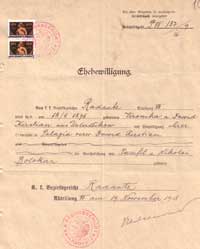
Photo 9
|
Additional information
Both the present article, as well as the one published in FILATELIA 10/2008, present a series of regulations related to the collecting of various taxes in Bucovina.
Besides the regulations already described, I mention a note published in the Official Gazette 22/23.03.1919 (5th April 1919) which refers to the collecting of the stamp tax according to article XLIII of the Law from 1914, which clarifies the work to be undertaken by the Collector of Revenues:
"To uphold the interest of the Public Treasury Ist order:
a) all acts and documents previously submitted, to be examined, and, if the payment of the stamp tax is not certified on the document, it is to be send to the Collector, with the tax to be collected for the Public Treasury
b) At registration offices, all documents are to be presented in person and the parties are to be instructed to pay the stamp tax, and if in default, to apply the ordinances described in paragraph 82. For documents which arrive by mail, without the stamp tax, the relevant parties are to be notified".
Also in the Official Gazette, 8/24.01.1919 (6.02.1919) there is an Ordinance regarding payment for stamps, the specially appointed clerk collecting the money will register the payment in a special register, with the mention of payment on the document, indicating the position in the register and the amount collected.
This Ordinance, together with Decree 3.745/18.12.1918, demonstrates a certain freedom in the application of the legal provisions by tax collectors, and explains the appearance on the same document of various notes, in different inks.
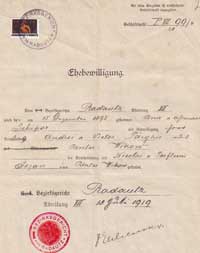
Photo 10
|
As the result of these regulations we can deduce that documents were collected at a central headquarters and were fiscally cancelled, after payment had been made. This procedure assisted residents in small or remote settlements, who did not have the opportunity to acquire the necessary stamps. This procedure however, was applied for a limited period, because the Order Sheet 5/1920 of the Postal Regional Direction published Order 5353 according to which requests send by mail and unstamped according to regulations are to be send back for proper stamps with the following instructions:
"This request cannot be take into consideration according to article 13, letter m of the Decree - Law 1638/20.04.1920, because it does not bear sufficient stamps. Requests should bear the stamp of ...lei...bani. In the special list returned to petitioners to be stamped according to the Law the date has to be precisely indicated. Attention is drawn to the fact that requests were to be stamped with 2 lei for each sheet and 50 bani for each attachment. If the offices have any doubt about the stamp tax, then the requests shall be directed to the registration service, which shall request the approval of the Regional Direction (No. 6368/II-I 1920)"
According to this regulation, no more documents stamped should be stamped at the "headquarters", a situation contradicted by documents in the archives which continue to be stamped until the middle of 1921. The enforcement of this law therefore was delayed in the newly united provinces of the Kingdom of Romania.
1920-21. Currency reforms.
Up to 1914, the leu had generally been on a parity with the French franc. Serious inflation occurred after the war, exacerbated by the Austro-Hungarian and Russian currencies in circulation after the unions, and the occupation banknotes left behind by the Germans. The Entente powers also refused to make good on their promise to pay, on Germany's behalf, for damages during the occupation. Valuables sent to Moscow for safe-keeping on Dec. 21, 1916, and July 27, 1917, including the National Bank treasury, the Crown jewels, archives, etc., were not returned. In June and July 1919, Hungarian crowns were overprinted for use in Romania, but through smuggling and forgery their number doubled. A unified paper currency came into use August 1, 1920. Foreign currencies were withdrawn from circulation between August 20 and 24, 1920, and exchanged between September 1 and 10 at the following rates:
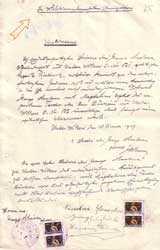
Business exempt from military duty
|
2 Hungarian crowns = 1 leu (but salaries of state employees in
Transylvania were converted at 3:1 in June 1920, so the currency
exchange might be seen as generous)
1 Romanov ruble = 1 leu
1 Lvov ruble = 0.30 leu
1 General Bank (occupation) leu = 1 leu
The latter were particularly notorious since they never had any backing in hard currency. Discussions concerning refunding of the occupation bank-notes by Germany continued until 1925, but nothing happened.
Exchange rates with the US dollar, in lei, (pre-war, 1 dollar = 5 lei)
year minimum average maximum
1919 15 18 24
1920 37 55 92
1921 57 86 140
1922 120 150 172
1923 179 203 228
1924 178 201 231
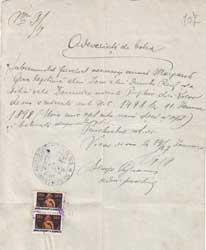
Certificate of baptism
|
Bibliography:
- Collection "Monitorul Bucovinei"1918-1922;
- Collection "Monitorul Oficial" 1918-1922;
- Bulletin Journal of Bessarabia 1919-1927;
- Annual Statistics of Romania 1911-1927;
- Bulletin Laws and Regulations 1913-1920;
- Stamps and Registration Law 1919, 1920;
- Collection "Bucovina, ziarul Românilor Bucovineni" 1919-1920;
- Collection "Glasul Bucovinei" 1918-1922;
- Sheet orders of the Regional Directorate Posts and Telegraphs in Bukovina 1920-1923;
- Sheet law and order on Bukovina Kingdom 1851-1871;
- Sheet imperial laws for kingdoms and the countries represented in the Imperial Senate 1870- 1913;
- Laws exceptional voted for major events will take place: Law moratória, Family Law fighters, stamp Law Help, ... 1915
Francisc Ambruş, 03/2009
|
 |
|
|
|

